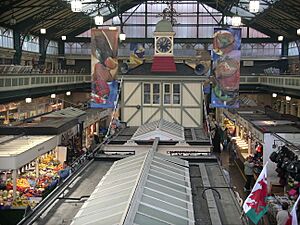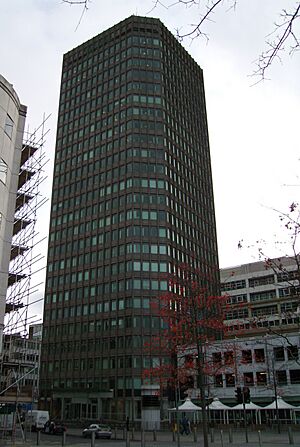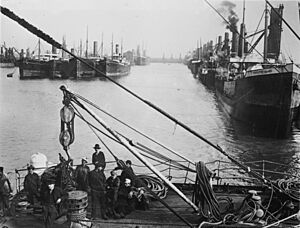Economy of Cardiff facts for kids
Cardiff is the capital city of Wales. It's a very important place for the Welsh economy. The city is growing fast, becoming a big center for services and a key part of the economy in south east Wales. Cardiff and the nearby Vale of Glamorgan produce a lot of Wales's economic output. More people are also traveling to Cardiff for work from the surrounding areas.
In the 1800s, Cardiff's economy was mostly about exporting coal and making steel. Cardiff's port became the world's most important coal port. It handled more coal than London and Liverpool!
Today, Cardiff is a hub for jobs that involve office work, often called white-collar professions. The city mainly relies on shops, finance, media, and tourism. Cardiff has been changing a lot since the late 1900s. Big improvements have happened in Cardiff city centre and Cardiff Bay.
How Cardiff's Economy Works
Money Made (GDP)
Cardiff and its nearby areas create almost 20% of all the money made in Wales, known as GDP (Gross Domestic Product). About 40% of the people who work in Cardiff travel in from other parts of south Wales every day.
Jobs in Cardiff
In 2008, about 190,948 people had jobs in Cardiff. This number has been growing steadily. Around 18,000 people also work for themselves. This means the total workforce is about 194,000 people.
After the decline of heavy industries like coal and steel in the late 1900s, Cardiff's economy now mostly relies on the service sector. This means jobs that provide services, not making things. Only about 9% of workers are in manufacturing.
The biggest job sector in Cardiff is public administration, education, and health. This includes jobs in government, schools, and hospitals. It employs 32% of the city's workers. Cardiff is also the main center for financial and business services in Wales. This sector provides jobs for 20% of the city's workforce. These two big sectors have created about 75% of Cardiff's economic growth since 1991.
About 20.4% of workers are in shops, hotels, and restaurants. This shows how much the retail and tourism industries are growing. A huge project costing £675 million improved Cardiff's St. David's Centre between 2006 and 2009. It now has 140,000 square meters (1,400,000 sq ft) of shopping space. This makes it one of the largest shopping centers in the UK.
Cardiff has more jobs in financial services than the average for Wales or Great Britain. The city also has many jobs in call centers, TV and film, and making medicines. Job growth in Cardiff has been strong in construction, shops, hotels, transport, banking, and public services.
People Without Jobs (Unemployment)
In 2010, the unemployment rate in Cardiff was 4.4%. This means 4.4% of people who wanted jobs couldn't find them. This was a bit higher than in 2004, when it was 2.2%. In 2010, Cardiff's unemployment rate was higher than the average for Wales and the UK.
The number of people claiming unemployment benefits in Cardiff doubled from about 5,000 in 2008 to 10,000 in 2010. More men (6.0%) were unemployed than women (2.2%) in the city.
How Much People Earn
Workers in Cardiff generally earn more than the average for Wales. In 2009, the average full-time worker in Cardiff earned almost £460 per week. This was close to the UK average of £490 and higher than the Welsh average of £440. Earnings in Cardiff grew by 45% between 1998 and 2009.
People who live in Cardiff earn about £483.20 per week on average. This is close to the UK average and much higher than the Welsh average. This suggests that people who travel into Cardiff for work might earn less than those who live there.
Total Value Added (GVA)
In 2007, Cardiff and the Vale of Glamorgan produced £9.432 billion in Gross Value Added (GVA). GVA measures the value of goods and services produced in an area. The GVA per person in Cardiff was £21,195. This was higher than both the Welsh and UK averages. The total GVA in Cardiff grew by 91% between 1995 and 2007.
Commuters
In 2008, out of 197,000 workers in Cardiff, 126,100 lived in the city. The other 70,900 people traveled into Cardiff from surrounding areas. Also, 27,100 people who live in Cardiff travel out of the city for work.
Education and Skills
Cardiff's population is generally more qualified than the average for Wales and the UK. This is partly because Cardiff has a younger population and several universities nearby. In 2008, 38.5% of people in Cardiff had a high-level qualification (like a degree), compared to 26.5% in Wales and 28.9% in the UK.
Fewer people in Cardiff have no formal qualifications compared to the rest of Wales and the UK. Only 11.1% in Cardiff had no qualifications, while it was 14.1% in Wales and 12.7% in the UK.
Cardiff is also highly qualified compared to other UK cities. About 32% of its residents have a degree or similar qualification. Only Edinburgh and Brighton have a higher percentage of degree-holders among major cities outside London.
Industries in Cardiff
Different industries have shaped Cardiff since the 1800s, and they continue to do so today.
Coal
What really made Cardiff a big city was the huge demand for coal. Coal was needed to make iron and steel. It was brought from places like Merthyr Tydfil to the sea by packhorse. Ironmakers wanted to make it cheaper to transport iron to ships in Cardiff. So, they got permission to build a canal.
Work on the Glamorganshire Canal started in 1790. It was 25 miles (40 km) long and took eight years to build, with 50 locks. Later, the Taff Vale Railway replaced the canal. Huge train yards appeared as new docks were built in Cardiff. This was all because of the massive worldwide demand for coal from south Wales. By 1907, Cardiff's docks had 11 kilometers (7 miles) of quayage, making it one of the largest dock systems in the world.
Cardiff's port, known as Tiger Bay, became the world's most important coal port for a while. Before World War I, the amount of coal handled at the port was more than London and Liverpool. In 1907, a business deal for a million pounds Sterling happened at Cardiff's Coal Exchange.
However, new docks in Barry from the 1890s and less demand for Welsh coal after World War I led to the port's decline. By the 1980s, large parts of Cardiff docks were empty and run-down. A big project then began to rebuild and improve South Cardiff.
Steel
The East Moors Steelworks, also called 'Dowlais by the Sea', was built in the 1890s. This made Cardiff a major steelmaking center. It was the first time a Welsh steel industry moved from inland to the coast. The factory mainly made steel plates for shipbuilding. By the 1930s, it was making half a million tons of steel each year. Even though the East Moors works closed in 1978, steel production still happens in Cardiff. The Celsa Steel UK plant in Cardiff Bay makes reinforcing bars and wire.
Shops and Retail

Shopping also plays a big role in Cardiff's jobs. Recent surveys have even called it the 6th best place to shop in the UK! Most of Cardiff's shops are in the city center around Queen Street and St. Mary's Street. There are also many shopping areas outside the city center.
Cardiff's retail sector has three main shopping centers in the city center: St. David's Centre, Queens Arcade, and the Capitol Centre. The expansion of St. David's Centre, called St. David's 2, created a huge new shopping area. It added about 200 shops, flats, and a John Lewis department store. This more than doubled the shopping space, making it one of the largest shopping centers in the UK. Besides these modern centers, Cardiff also has many beautiful Victorian shopping arcades, like High Street Arcade and Castle Arcade.
Queen Street is home to many well-known chain stores. St. Mary Street and High Street have Wales's oldest and largest department store, Howells, along with smaller independent shops. The Hayes is home to Spillers Records, which started in 1894 and is the world's oldest record shop! Cardiff also has S A Brain, a brewery that has been in the city since 1882.
Cardiff has several markets. These include the large Victorian indoor Central Market, Splott Market, and farmers' markets that sell local and organic produce.
Since the new St. David's shopping area opened, up to one million extra shoppers visit Cardiff each month.
Money and Business (Finance)
Cardiff is doing very well as a center for financial and business services. These jobs employ 50,000 people in the city. Many big, well-known financial companies have offices in Cardiff. They have continued to grow because of a good business model and a skilled workforce.
Cardiff is the main center for finance and business services in Wales. In 2003, 33,850 people worked in this sector. This was a higher percentage than in Wales or Great Britain as a whole. Cardiff was recently ranked seventh among the top 50 European cities for attracting foreign investment.
Many large companies have big call centers in Cardiff. These include Legal & General, Admiral Insurance, HBOS, Zurich, and ING Direct. Many of these are in Cardiff's office towers like Capital Tower. Other major employers include NHS Wales and the National Assembly for Wales.
TV, Radio, and News (Media)
Cardiff is home to the Welsh media. It has a large media sector with BBC Wales, S4C, and ITV Wales all having studios in the city. Jobs in this sector have grown a lot recently. It now employs 2.1% of the city's workforce.
BBC Radio Wales and Radio Cymru have their main studios in Cardiff. Capital FM and Heart FM also have studios here. Many companies that create content, like design, animation, gaming, TV production, film, music, and journalism businesses, are also growing in Cardiff.
Computers and Communication (ICT)
Cardiff has seen a lot of investment in its computer and communication technology (ICT) in recent years. The city has modern communication systems. Many industries in this sector have moved from making large amounts of products to making specialized, high-value products. This kind of research and development is expected to drive the most economic growth in this sector. Cardiff is also home to the European Centre of Research and Development.
Visitors and Tourism
| Attraction | Number of Visitors |
|---|---|
| Wales Millennium Centre | 882,962 |
| St Fagans National History Museum | 642,289 |
| National Museum | 353,079 |
| Cardiff Castle | 223,792 |
| Senedd building | 204,110 |
| Cardiff Bay Visitor Centre | 196,764 |
| Techniquest | 178,366 |
| Country of origin | Number of Visitors |
|---|---|
| France | 44,000 |
| Republic of Ireland | 36,000 |
| Germany | 34,000 |
| United States | 26,000 |
| Australia | 22,000 |
Cardiff is one of the most popular tourist cities in the United Kingdom. In 2009, it had 14.6 million visitors, a 50% increase in 10 years! These visitors spent £703.6 million in the city. Cardiff has been named a top destination by many travel guides.
The big changes in Cardiff in the early 2000s have made it much more popular for foreign visitors. Most foreign tourists come from France and Republic of Ireland. Cardiff is also the fifth most visited UK city by Australians. Visitors often say they like Cardiff because it's a "glorious capital city, with an historical resonance."
Cardiff's most popular attraction is the Wales Millennium Centre. In 2007, almost 900,000 people visited it. Other popular spots include the National Museum, the St Fagans National History Museum, and Cardiff Castle. Cardiff also hosts major sporting events at the Millennium Stadium, bringing in thousands of visitors.
There are many hotels in the city, including the five-star Hilton and St David's Hotel & Spa in Cardiff Bay. Overall, the city's hotels have almost 9,000 beds available.
Surveys show that 96% of visitors found their trip to Cardiff "enjoyable" or "very enjoyable." Most visitors (97%) would recommend visiting the city. The most popular places to visit were Cardiff Bay, the shops, and Cardiff Castle.
Science and Research
Cardiff has about 100 companies and organizations related to bioscience. Cardiff University is also becoming well-known internationally for its research in bioscience. Big international companies like GE Healthcare have offices here, along with many smaller, innovative companies. These companies are attracted by the university and its many students and researchers in bioscience.
Buildings and Development
Cardiff is currently undergoing several big building projects. One is the £270 million International Sports Village in Cardiff Bay. This will be part of the London 2012 Olympics. It has the only Olympic-standard swimming pool in Wales, the Cardiff International Swimming Pool, which opened in 2008.
The old Tiger Bay area, which was once home to one of the UK's earliest non-white immigrant communities, has been completely rebuilt. It is now Cardiff Bay – a popular area for culture, entertainment, and nightlife. Much of this growth is thanks to the building of the Cardiff Barrage.
Two large international business parks are planned for the north of Cardiff. The average house price in Cardiff is £181,226. Cardiff also has a strong rental market, especially in the city center and Cardiff Bay.



